Understanding the types of rain
Understanding the types of rain

Would you like to rain? maybe the word rain is familiar to be heard, the rain that comes at a certain time and is anticipated by living beings gives importance to the life of living things. Rain itself has another meaning according to the researchers. The rain is so prevalent around the world that the researchers also have other meanings about rain.
Rain is a precipitation in the form of liquid. Rain requires a thick layer of atmosphere to meet temperatures above the melting point of ice near and above the earth's surface. On Earth, Rain is a process of condensing water vapor in the atmosphere into a grain that is heavy enough to fall and usually arrives on land. The occurrence of rain is caused by factors
Well, after knowing the meaning of rain, this time we will discuss about the types of rain along with pictures.
1.Cycloneal Rain
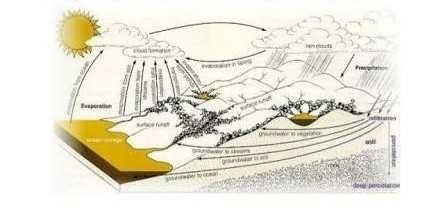
Cyclonal rain is the rain that occurs due to rising hot air from the surface of the earth accompanied by winds that swirl at a certain point. Types of cyclone rain usually only occur in the area around the equator. Identical features of this rain we can see with a dark clouds of sudden concentration and produce a very heavy rain of rain.
2. Zenithal Rain
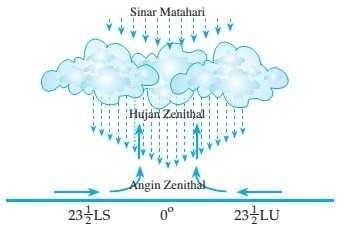
Senryal rain (zenithal) is the rain caused by the encounter of the southeastern winds and eastern eastern breeze. This type of rain also generally only happens around the equator. The hot air of the two winds rises into the atmosphere and causes the temperature around the clouds to slowly rise. This temperature drop, there was a condensation that gradually caused the cloud to reach its saturation point. It was at this point that the rain of senithal then descended into the earth
3. Orographic RRain
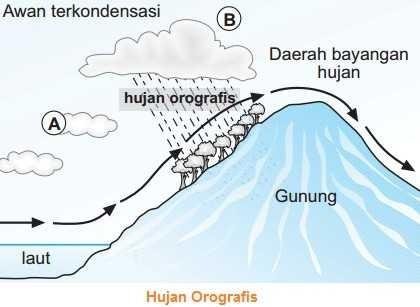
Orographic rain is the rain that occurs due to the movement of the cloud towards the horizontal wind. Winds carry clouds reaching a mountainous area and are condensed by the cold temperatures that surround it. Condensation gradually makes the cloud reach its saturation point so that it creates hufront.
4. Frontal Rain
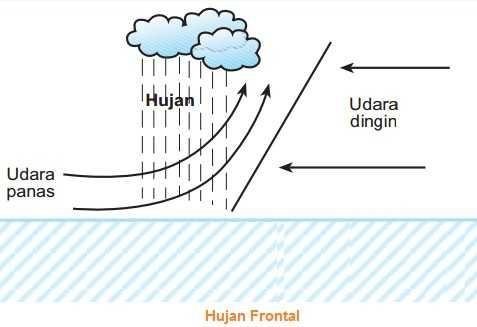
Frontal rain is a rainfall caused by a meeting of cold air masses with hot air masses. The two air encounters took place at a place called "front field". This meeting resulted in a period of cold air under and stimulated the occurrence of rain around the front of the field.
5. Rain of Muson
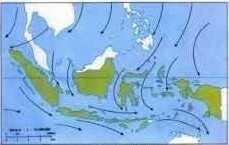
The monsoon rain is the rain caused by the influence of monsoon winds. The monsoon itself is due to the influence of the annual solar motion of the sun to the equator of the earth. In Indonesia, this type of rain occurs between October and April, while in East Asia occurs between May and August. Because of the wind cycle and monsoon rains we know the existence of the rainy season and the dry season.
6. Artificial Rain
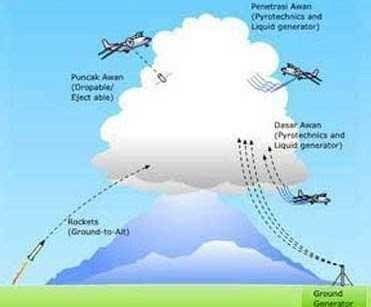
Artificial rain is the rain that occurs due to human intervention in manipulating the physical state of the local atmosphere, precisely by utilizing the process of growth and incorporation in the formation of clouds (ice nucleation). Among other types of rain, artificial rain is what usually produces only a small amount of rainfall.
Based on the type and size of the particles, the rain is divided into 5 types. Type of rain types include:
Drizzle Rain is rain that drops particles of water with granules diameter <0.5 mm.
Heavy rain is rain that drops particles of water with granules of> 7.0 mm in diameter.
Snowfall is rain that drops ice crystals with temperatures below 0 Celsius.
Ice Rain is a rain that drops ice bigger than snow. The phenomenon of hail is very rare
Acid rain is rain that drops water particles with high acidity. usually this rainwater contains NO3 or H2S compounds.
Type of Rain Based on its bulk
BMKG or Meteorological and Geophysical Agency classify the rain based on how much bulk or the amount of water received by the earth's surface in a period of rain. This grouping produces a type of rainfall that includes moderate rain (20 to 50 mm / day), dense (50 sd 100 mm / day), and very heavy rain (> 100 mm / day).
Well, that is the classification type of rain type based on 3 parameters, that is based on the process of occurrence, type of particle, and the amount of water received by the earth's surface (rainfall). Hopefully this exposure can add to your understanding of hydrological cycle learning.
Summarized from the link below:
http://www.pelajaran.co.id/2017/18/pengertian-hujan-jenis-jenis-hujan-dan-gambar-lengkap.html
http://www.ebiologi.net/2016/09/jenis-jenis-hujan-dan-gambarnya.html?m=1
https://minidjleg.blogspot.co.id/2017/06/6-macam-jenis-jenis-hujan-beserta.html?m=1

Congratulations! This post has been upvoted from the communal account, @minnowsupport, by Karlina54 from the Minnow Support Project. It's a witness project run by aggroed, ausbitbank, teamsteem, theprophet0, someguy123, neoxian, followbtcnews, and netuoso. The goal is to help Steemit grow by supporting Minnows. Please find us at the Peace, Abundance, and Liberty Network (PALnet) Discord Channel. It's a completely public and open space to all members of the Steemit community who voluntarily choose to be there.
If you would like to delegate to the Minnow Support Project you can do so by clicking on the following links: 50SP, 100SP, 250SP, 500SP, 1000SP, 5000SP.
Be sure to leave at least 50SP undelegated on your account.